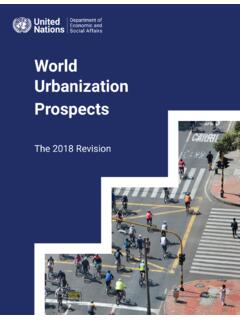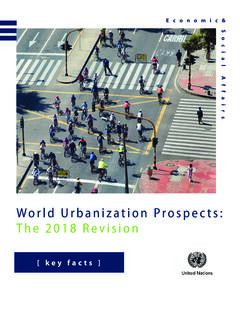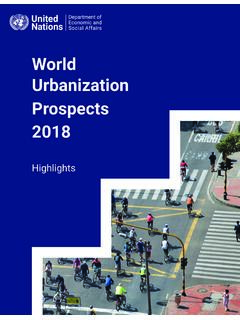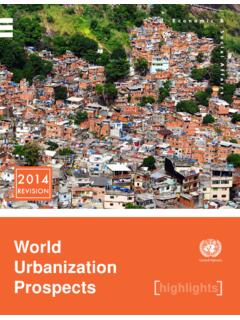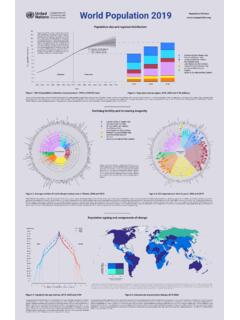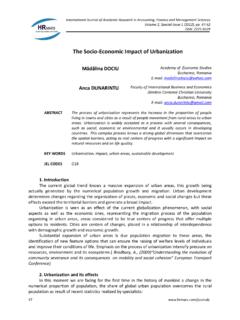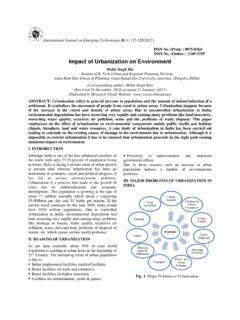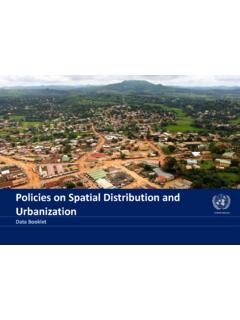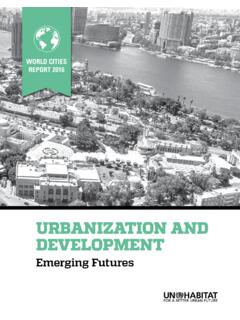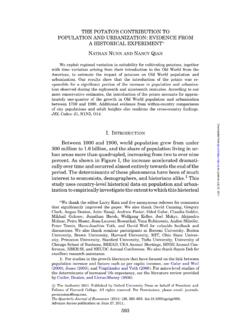Transcription of The speed of urbanization around the world I
1 In recent decades, the world has been urbanizing rapidly. In 1950, only 30 per cent of the world s population lived in urban areas, a proportion that grew to 55 per cent by 2018. The global urbanization rate masks important differences in urbanization levels across geographic regions. Northern America is the most urbanized region, with 82 per cent of its population residing in urban areas, whereas Asia is approximately 50 per cent urban, and Africa remains mostly rural with 43 per cent of its population living in urban areas in 2018 (United Nations, 2018). Regional variations in levels of urbanization raises the question of whether some regions urbanize faster or slower.
2 To address this question, the following analysis compares the increase in the percentage urban in several less developed regions between 1950 and 2015 with historical trends of urbanization in the more developed regions. Since pace and level of urbanization are related, the analysis across regions compares the speed of urbanization at equal levels of the percentage urban. Figure 1 presents changes in the percentage urban across several regions or subregions of the world . The black line refers to urbanization in the more developed regions between 1800 and 2015 and serves as a base line for the comparison. The black line shows an S-shaped profile, indicating that the rise in the percentage urban was relatively slow at low levels of urbanization , before accelerating at medium levels and then falling again at elevated levels of urbanization .
3 For the sake of comparison, trends in urbanization for less developed regions start in each case with the percentage urban in 1950, which is plotted at the point along the black line when the more developed regions experienced the same percentage of population living in urban areas. In cases where the subsequent trajectory of a region lies above the black line, the pace of urbanization , starting from an equal level of urbanization , was relatively more rapid in that region, albeit at later date. Conversely, if the trajectory of a region lies below the black line, the speed of urbanization was lower in that region compared to the historical experience of the more developed regions.
4 The speed of urbanization around the worldThe speed of urbanization in sub-Saharan Africa between 1950 and 2015, for example, represented by the blue line, was higher than for the more developed regions between 1850 and 1915, represented by the black line. In 1950, the percentage urban in sub-Saharan Africa was about 11 per cent, equal to the urbanization level of the more developed regions in 1850. Over the following 65 years, the percentage urban rose more rapidly in sub-Saharan Africa, reaching 39 per cent in 2015, while the more developed regions reached a percentage urban of only 34 per cent in 1915. The pace of urbanization in other less developed regions can be compared with that of the more developed regions in similar terms (figure 1).
5 Data sources: 1800-1925: Taken from Grauman (1976: 32); 1930-1945: Interpolated values; 1950-2015: United Nations (2018).Notes: Based on and updated from Dyson (2010: 148). The x-axis shows the number of years from the starting year of the trajectory of each 2018/1 December 2018 Figure 1. Levels and trends of urbanization in selected regions0102030405060708090 Percentage urbanYears (interval between tick marks is one decade)More developed regionsSub-Saharan AfricaNorthern AfricaEastern AsiaSouth-Central AsiaSouth-Eastern AsiaWestern AsiaLatin America and theCaribbean1800201519502015201520152015 201520152015195019501950195019501950 urbanization has been faster in some less developed regions compared to historical trends in the more devel-oped regions Compared to the experience of the more developed regions, the speed of urbanization has been higher in some less developed regions since 1950, except for Northern Africa and South-Central Asia.
6 urbanization has been relatively rapid in sub-Saharan Africa, Eastern Asia, Western Asia and Latin America and the Caribbean. Eastern Asia is the region that had experienced the most rapid urbanization , especially over the last 20 years. The share of the urban population in Eastern Asia more than tripled in 65 years, rising from 18 to 60 per cent between 1950 and 2015, while a similar change in the more developed regions required about 80 years, between 1875 and 1955. urbanization has slowed down in some geographic re-gions The speed of urbanization decreased in recent decades in Northern Africa, Western Asia and Latin America and the Caribbean.
7 For Northern Africa, in the decades immediately after 1950, the trend in urbanization followed closely that of the more developed regions; the recent trend, however, is clearly distinct. The speed of urbanization in Northern Africa has fallen significantly over the last decades. Similarly, in recent decades urbanization in Western Asia and, to a lesser degree, in Latin America and the Caribbean, has slowed down after a period of rapid increase in the decades after 1950. In South-Central Asia, the pace of urbanization has been steady since 1950 and the region did not experience the phase of accelerated urbanization observed in the other regions (figure 1).
8 Despite these distinctive trajectories, all regions have continuously become more urban since diversity in urbanization conceals large varia-tions across countries The speed of urbanization also varies substantially across countries. Figure 2 illustrates the diversity in the pace of urbanization for some populous countries located in the regions considered here. Starting at almost identical levels in 1950, trajectories of urbanization have been very similar for China and Indonesia. In contrast, despite having comparable levels in 1950, Brazil and Egypt followed very different trajectories thereafter, with Brazil experiencing rapid urbanization while the trend in Egypt has been flat since the 1970s, a reflection of the official definition of cities not accounting for the recent urbanization of rural to a slow process of reclassification of rural areas as urban, urbanization in India has progressed more slowly compared to other countries at similar levels of the percentage urban.
9 In contrast, starting from a very low level of urbanization in 1950, Ethiopia has undergone relatively rapid urbanization compared both to the historical experience of the more developed regions and to other developing countries at similar levels of urbanization . Causes of disparities of urbanizationChanges in the level and pace of urbanization are determined by several factors, including differences in natural population growth between rural and urban areas, rural-to-urban and international migration, and the expansion of urban settlements through annexation and reclassification of rural settlements into cities. At very high levels, the urbanization rate reaches saturation and normally slows down.
10 The level and speed of urbanization , as well as the underlying demographic drivers are closely linked with economic transformation as well as with spatial planning, including housing, infrastructure and service sources: 1800-1925: Taken from Grauman (1976: 32); 1930-1945: Interpolat-ed values; 1950-2015: United Nations (2018).Notes: Based on and updated from Dyson (2010: 148). The x-axis shows the number of years from the starting year of the trajectory of each , Tim (2010). Population and Development: The Demographic Transition, London/New York: Zed , John V. (1976). Orders of magnitude of the world s urban population in history, United Nations Population Bulletin, No.
